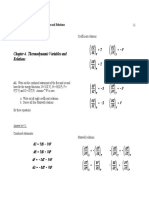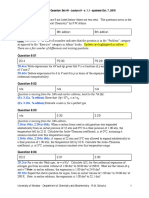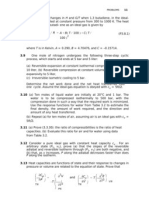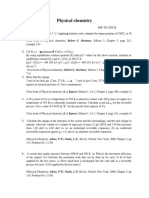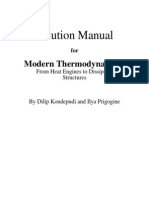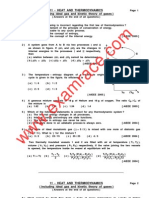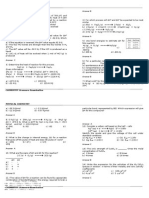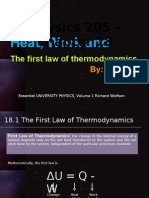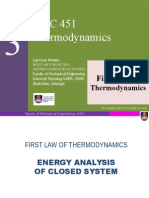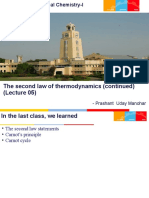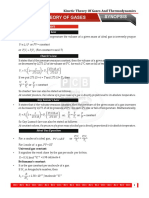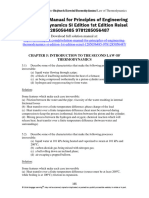Set 1 Question 13.01 : (Ex. 5.4a, 7 Edition) - (Ex. 5.4b, 7 Edition)
Set 1 Question 13.01 : (Ex. 5.4a, 7 Edition) - (Ex. 5.4b, 7 Edition)
Uploaded by
Jon Vincent BallesteroOriginal Description:
Original Title
Copyright
Available Formats
Share this document
Did you find this document useful?
Is this content inappropriate?
Report this DocumentCopyright:
Available Formats
Set 1 Question 13.01 : (Ex. 5.4a, 7 Edition) - (Ex. 5.4b, 7 Edition)
Set 1 Question 13.01 : (Ex. 5.4a, 7 Edition) - (Ex. 5.4b, 7 Edition)
Uploaded by
Jon Vincent BallesteroCopyright:
Available Formats
59-240 Physical Chemistry - Question Set #13 - Lecture 13 - v. 2.0 - updated Nov.
1, 2018
Assigned questions for Lecture 13 are listed below. The questions occur in the following
editions of “Physical Chemistry” by P.W. Atkins:
10th edition 9th edition 8th edition
Note: The letter “P” in front of a number indicates that the question is in the “Problem” category
as opposed to the “Exercise” category in Atkins’ books. Updates are highlighted in yellow.
There are a lot of questions that are now missing, which is unfortunate. Note: There are two
separate problem sets associated with Lecture 13.
Set 1
Question 13.01*
n/a n/a n/a n/a
Missing after 7th Ed. (not sure why).
(Ex. 5.4a, 7th edition). Express (∂S/∂V)T in terms of α and κT.
(Ex. 5.4b, 7th edition). Express (∂S/∂p)T in terms of α.
Question 13.02
3E.1 3D.1 3.16 3.16
Same question format, variation in numbers between 10th and 11th Eds. vs. 8th and 9th Eds.
3.16(a) Suppose that 3.0 mmol N2(g) occupies 36 cm3 at 300 K and expands to 60 cm3. Calculate
ΔG for the process.
3.16(b) Suppose that 2.5 mmol Ar(g) occupies 72 dm3 at 298 K and expands to 100 dm3.
Calculate ΔG for the process.
3E.1(a) Suppose that 2.5 mmol N2(g) occupies 42 cm3 at 300 K and expands isothermally to 600
cm3. Calculate ΔG for the process.
3E.1(b) Suppose that 6.0 mmol Ar(g) occupies 52 cm3 at 298 K and expands isothermally to 122
cm3. Calculate ΔG for the process.
Question 13.03
3E.2 3D.2 3.17 3.17
Same questions.
3D.2(a) The change in the Gibbs energy of a certain constant–pressure process was found to fit
the expression ΔG/J = −85.40 + 36.5(T/K). Calculate the value of ΔS for the process.
3D.2(b) The change in the Gibbs energy of a certain constant–pressure process was found to fit
the expression ΔG/J = −73.1 + 42.8(T/K). Calculate the value of ΔS for the process.
University of Windsor - Department of Chemistry and Biochemistry - R.W. Schurko 1
59-240 Physical Chemistry - Question Set #13 - Lecture 13 - v. 2.0 - updated Nov. 1, 2018
Question 13.04*
n/a n/a 3.18 3.18
Missing from 10th and 11th Eds. No idea why.
3.18(a) Calculate the change in Gibbs energy of 35 g of ethanol (mass density 0.789 g cm-3)
when the pressure is increased isothermally from 1 atm to 3000 atm.
3.18(b) Calculate the change in Gibbs energy of 25 g of methanol (mass density 0.791 g cm-3)
when the pressure is increased isothermally from 100 kPa to 100 MPa. Take κT = 1.26 × 10-9 Pa-1.
Question 13.05*
n/a n/a n/a n/a
Missing in all editions after 7th Ed.
(Ex. 5.8a, 7th edition). When 2.00 mol of has at 330 K and 3.50 atm is subject to isothermal
compression, its entropy decreases by 25.0 J K-1. Calculate (a) the final pressure of the gas and
(b) the ΔG for the compression.
(Ex. 5.8b, 7th edition). When 3.00 mol of has at 230 K and 150 kPa is subject to isothermal
compression, its entropy decreases by 15.0 J K-1. Calculate (a) the final pressure of the gas and
(b) the ΔG for the compression.
Question 13.06*
n/a n/a 3.19 3.19
Missing from the 10th and 11th Eds. Not sure why. But: See E3E.6 in 11th Ed. for something
similar (see Q13.09 below).
3.19(a) Calculate the change in chemical potential of a perfect gas when its pressure is increased
isothermally from 1.8 atm to 29.5 atm at 40°C.
3.19(b) Calculate the change in chemical potential of a perfect gas that its pressure is increased
isothermally from 92.0 kPa to 252.0 kPa at 50°C.
Question 13.07*
n/a n/a 3.2 3.2
Missing from the 10th Ed. Not sure why.
3.20(a) The fugacity coefficient of a certain gas at 200 K and 50 bar is 0.72. Calculate the
difference of its molar Gibbs energy from that of a perfect gas in the same state.
3.20(b) The fugacity coefficient of a certain gas at 290 K and 2.1 MPa is 0.68. Calculate the
difference of its molar Gibbs energy from that of a perfect gas in the same state.
University of Windsor - Department of Chemistry and Biochemistry - R.W. Schurko 2
59-240 Physical Chemistry - Question Set #13 - Lecture 13 - v. 2.0 - updated Nov. 1, 2018
Question 13.08
3E.3 3D.3 3.21 3.21
Sort of the same style question. Use of mass density in 10th Ed. is similar to Question 13.04.
3.21(a) Estimate the change in the Gibbs energy of 1.0 dm3 of benzene when the pressure acting
on it is increased from 1.0 atm to 100 atm.
3.21(b) Estimate the change in the Gibbs energy of 1.0 dm3 of water when the pressure acting on
it is increased from 100 kPa to 300 kPa.
3E.3(a) Estimate the change in the Gibbs energy and molar Gibbs energy of 1.0 dm3 of octane
when the pressure acting on it is increased from 1.0 atm to 100 atm. The mass density of octane
is 0.703 g cm−3.
3E.3(b) Estimate the change in the Gibbs energy and molar Gibbs energy of 100 cm3 of water
when the pressure acting on it is increased from 100 kPa to 500 kPa. The mass density of water
is 0.997 g cm−3.
Question 13.09
3E.6 3D.4 3.22 3.22
Same question in 10th and earlier editions.
3D.4(a) Calculate the change in the molar Gibbs energy of hydrogen gas when its pressure is
increased isothermally from 1.0 atm to 100.0 atm at 298 K.
3D.4(b) Calculate the change in the molar Gibbs energy of oxygen when its pressure is increased
isothermally from 50.0 kPa to 100.0 kPa at 500 K.
Changed in 11th Ed.
3E.6(a) Calculate the change in the molar Gibbs energy of a perfect gas when its pressure is
increased isothermally from 1.0 atm to 100.0 atm at 298 K.
3E.6(b) Calculate the change in the molar Gibbs energy of a perfect gas when its pressure is
increased isothermally from 50.0 kPa to 100.0 kPa at 500 K.
University of Windsor - Department of Chemistry and Biochemistry - R.W. Schurko 3
59-240 Physical Chemistry - Question Set #13 - Lecture 13 - v. 2.0 - updated Nov. 1, 2018
Set 2
Question 13.10*
n/a n/a P3.22 P3.22
Part (a) is missing in all editions after the 7th Ed, in 9th-11th Eds.
(Ex. 5.14a, 7th edition). The molar Helmholz energy of a certain gas is given by
a
Am = − − RT (ln Vm − b) + f (T )
Vm
where a and b are constants and f(T) is a function of temperature only. Obtain the equation of
state of the gas.
(Ex. 5.14b, 7th edition). The molar Gibbs energy of a certain gas is given by
1 1
Gm = RT ln p + A + Bp+ 2 Cp 2+ 3 Dp 3
where A, B, C and D are constants. Obtain the equation of state of the gas.
Question 13.11
P3E.4 P3D.4 P3.23ab P3.23ab
9th Ed. and earlier:
P3.23 Evaluate (∂S/∂V)T for (a) a van der Waals gas, (b) a Dieterici gas (see Lecture 4, real
gases). For an isothermal expansion, for which kind of gas (and a perfect gas) will ΔS be
greatest?Explain your conclusion.
Changed in the 10th:
3D.4 Two empirical equations of state of a real gas are as follows:
Evaluate (∂S/∂V)T for each gas. For an isothermal expansion, for which kind of gas (also consider
a perfect gas) will ΔS be greatest? Explain your conclusion.
And yet again in the 11th (see next page):
University of Windsor - Department of Chemistry and Biochemistry - R.W. Schurko 4
59-240 Physical Chemistry - Question Set #13 - Lecture 13 - v. 2.0 - updated Nov. 1, 2018
Question 13.12*
P3E.1 3D.1 n/a n/a
Missing in 8th and 9th Eds.
(P5.1, 7th edition). Calculate ΔrGo (375 K) for the reaction 2CO(g) + O2(g) → 2CO2(g) from the
Gibbs-Helmholz equation, and the values of ΔrGo (298 K) and ΔrHo (298 K).
11th Ed.:
University of Windsor - Department of Chemistry and Biochemistry - R.W. Schurko 5
59-240 Physical Chemistry - Question Set #13 - Lecture 13 - v. 2.0 - updated Nov. 1, 2018
Question 13.13*
n/a n/a P3.24 P3.24
Missing from the 10th ed. Not sure why.
P3.24 Show that, for a perfect gas, (∂U/∂S)V = T and (∂U/∂V)S = -p.
Question 13.14*
n/a P3D.5 P3.25 P3.25
Same questions in 10th and earlier. Missing in 11th. However, this is just what is asked of you in
classes for L13, and part of this is covered in tutorial.
3D.5 Two of the four Maxwell relations were derived in the text, but two were not. Complete
their derivation by showing that (∂S/∂V)T = (∂p/∂T)V and (∂T/∂p)S = (∂V/∂S)p.
Question 13.15*
n/a 3D.6a,b P3.26, P3.30 P3.26, P3.30
In the 10th Ed, the problems are joined together into one (a and b). Missing from the 11th Ed.
P3.26 Use the Maxwell relations to express the derivatives (a) (∂S/∂V)T and (∂V/∂S)p and
(b) (∂p/∂S)V and (∂V/∂S)p in terms of the heat capacities, the expansion coefficient α, and the
isothermal compressibility, κT.
P3.30 The Joule coefficient, µJ, is defined as µJ = (∂T/∂V)U. Show that µJCV = p – aT/ΚT.
3D.6 (a) Use the Maxwell relations to express the derivatives (∂S/∂V)T, (∂V/∂S)p, (∂p/∂S)V, and
(∂V/∂S)p in terms of the heat capacities, the expansion coefficient α = (1/V)(∂V/∂T)p, and the
isothermal compressibility, κT = −(1/V) (∂V/∂p)T.
(b) The Joule coefficient, µj, is defined as = (∂T/∂V)U. Show that µJCV = p − αT/κT.
Question 13.16*
n/a n/a P3.27 P3.27
Missing from the 10th ed. Not sure why.
3.27 Use the Maxwell relations to show that the entropy of a perfect gas depends on the volume
as S ∝ R ln V.
University of Windsor - Department of Chemistry and Biochemistry - R.W. Schurko 6
59-240 Physical Chemistry - Question Set #13 - Lecture 13 - v. 2.0 - updated Nov. 1, 2018
Question 13.17*
n/a n/a P3.28 P3.28
Missing from the 10th ed. Not sure why.
P3.28 Derive the thermodynamic equation of state
( ∂T ) ( ∂T )
∂H ∂V
=V−T
p p
Derive an expression for (∂H/∂p)T for (a) a perfect gas and (b) a van der Waals gas. In the latter
case, estimate its value for 1.0 mol Ar(g) at 298 K and 10 atm. By how much does the enthalpy
of the argon change when the pressure is increased isothermally to 11 atm?
Question 13.18*
n/a P3D.7 P3.33 P3.33
Same questions, except for addition of highlighted term in 10th Ed, which seems to be a misprint.
And of course…missing from the illustrious 11th Ed.
3D.7 Suppose that S is regarded as a function of p and T. Show that TdS = CpdT −αTVdp. Hence,
show that the energy transferred as heat when the pressure on an incompressible liquid or solid is
increased by Δp is equal to αTVΔp, where O = (1/V)(9V/9T)p. Evaluate q when the pressure
acting on 100 cm3 of mercury at 0 °C is increased by 1.0 kbar. (α = 1.82 × 10-4 K-1.)
10th Ed. misprint (online Ed). Likely, this is suppose to be: α = (1/V)(∂V/∂T)p
Note for F2018:
It seems that the Atkins editing team has removed most question involving partial
derivatives and the second-law toolbox - contrary to most of major texts on
thermodynamics. Lots more unhelpful discussion questions though!
University of Windsor - Department of Chemistry and Biochemistry - R.W. Schurko 7
59-240 Physical Chemistry - Question Set #13 - Lecture 13 - v. 2.0 - updated Nov. 1, 2018
Answer 13.01*
n/a n/a n/a n/a
Missing after 7th Ed. (not sure why).
University of Windsor - Department of Chemistry and Biochemistry - R.W. Schurko 8
59-240 Physical Chemistry - Question Set #13 - Lecture 13 - v. 2.0 - updated Nov. 1, 2018
Answer 13.04*
n/a n/a 3.18 3.18
Missing from 10th and 11th Eds. No idea why.
Note: You will not have to decide whether to integrate or assume that the volume is constant in
an exam situation. This will be made very clear.
University of Windsor - Department of Chemistry and Biochemistry - R.W. Schurko 9
59-240 Physical Chemistry - Question Set #13 - Lecture 13 - v. 2.0 - updated Nov. 1, 2018
University of Windsor - Department of Chemistry and Biochemistry - R.W. Schurko 10
59-240 Physical Chemistry - Question Set #13 - Lecture 13 - v. 2.0 - updated Nov. 1, 2018
Answer 13.05*
n/a n/a n/a n/a
Missing in all editions after 7th Ed.
University of Windsor - Department of Chemistry and Biochemistry - R.W. Schurko 11
59-240 Physical Chemistry - Question Set #13 - Lecture 13 - v. 2.0 - updated Nov. 1, 2018
Answer 13.06*
n/a n/a 3.19 3.19
Missing from the 10th Ed. Not sure why.
Answer 13.07*
n/a n/a 3.2 3.2
Missing from the 10th Ed and later. Not sure why.
University of Windsor - Department of Chemistry and Biochemistry - R.W. Schurko 12
59-240 Physical Chemistry - Question Set #13 - Lecture 13 - v. 2.0 - updated Nov. 1, 2018
Answer 13.10a*
n/a n/a P3.22 3.19
Part (a) is missing in all edition after the 7th Ed in 9th and 10 Eds.
University of Windsor - Department of Chemistry and Biochemistry - R.W. Schurko 13
59-240 Physical Chemistry - Question Set #13 - Lecture 13 - v. 2.0 - updated Nov. 1, 2018
Answer 13.12*
n/a n/a n/a n/a
Missing in all editions after 7th Ed.
University of Windsor - Department of Chemistry and Biochemistry - R.W. Schurko 14
59-240 Physical Chemistry - Question Set #13 - Lecture 13 - v. 2.0 - updated Nov. 1, 2018
Answer 13.13*
n/a n/a P3.24 P3.24
Missing from the 10th ed and later. Not sure why.
University of Windsor - Department of Chemistry and Biochemistry - R.W. Schurko 15
59-240 Physical Chemistry - Question Set #13 - Lecture 13 - v. 2.0 - updated Nov. 1, 2018
Answer 13.15*
n/a 3D.6a,b P3.26, P3.30 P3.26, P3.30
In the 10th Ed, the problems are joined together into one (a and b). Missing from the 11th Ed.
University of Windsor - Department of Chemistry and Biochemistry - R.W. Schurko 16
59-240 Physical Chemistry - Question Set #13 - Lecture 13 - v. 2.0 - updated Nov. 1, 2018
University of Windsor - Department of Chemistry and Biochemistry - R.W. Schurko 17
59-240 Physical Chemistry - Question Set #13 - Lecture 13 - v. 2.0 - updated Nov. 1, 2018
Answer 13.16*
n/a P3.27 P3.27
Missing from the 10th ed. Not sure why.
Answer 13.17*
n/a P3.28 P3.28
Missing from the 10th ed. Not sure why.
University of Windsor - Department of Chemistry and Biochemistry - R.W. Schurko 18
59-240 Physical Chemistry - Question Set #13 - Lecture 13 - v. 2.0 - updated Nov. 1, 2018
Answer 13.18*
n/a P3D.7 P3.33 P3.33
Same questions, except for addition of highlighted term in 10th Ed, which seems to be a misprint.
And of course…missing from the illustrious 11th Ed.
University of Windsor - Department of Chemistry and Biochemistry - R.W. Schurko 19
You might also like
- DehoffDocument11 pagesDehoffVictor Manuel Romero Herrera100% (4)
- Solution Manual: Modern ThermodynamicsDocument12 pagesSolution Manual: Modern ThermodynamicsMuhammed Fuad0% (1)
- Problems 2 1st Law PDFDocument10 pagesProblems 2 1st Law PDFKrystel Monica Manalo0% (1)
- Heat Capacity Ratio of GasesDocument14 pagesHeat Capacity Ratio of GasesLinda Yao100% (1)
- MeDocument88 pagesMeEk-ek Felizardo Almoroto Gontiñas Jr.No ratings yet
- 240 - E13 Soal AtkinsDocument14 pages240 - E13 Soal AtkinsMella Kusuma SariNo ratings yet
- Phy Chem Equations PS PDFDocument7 pagesPhy Chem Equations PS PDFKarl RodernoNo ratings yet
- 240 E12Document7 pages240 E12Marielle PerejonNo ratings yet
- Physical ChemDocument8 pagesPhysical ChemjahmanNo ratings yet
- 59-240 Physical Chemistry - Question Set #10 - Lecture 10 - v. 2.0 - Updated Oct. 14, 2018Document8 pages59-240 Physical Chemistry - Question Set #10 - Lecture 10 - v. 2.0 - Updated Oct. 14, 2018Emilia IkuNo ratings yet
- Solution2 Pset3 PDFDocument4 pagesSolution2 Pset3 PDFjohnNo ratings yet
- Burrows2e Solutions Ch13Document50 pagesBurrows2e Solutions Ch13mnemonia0% (1)
- Microsoft Word - 4-State of Matter - Gaseous StateDocument5 pagesMicrosoft Word - 4-State of Matter - Gaseous StateSatya KamNo ratings yet
- Chemistry Question BankDocument55 pagesChemistry Question BankPadma PriyaNo ratings yet
- Gaseous StateDocument8 pagesGaseous StateGadde Gopala KrishnaNo ratings yet
- Thermodynamics Answer KeyDocument5 pagesThermodynamics Answer KeyHevi Angelo Rios TadenaNo ratings yet
- Assessment 2: LU 5-9 Physics II: Vaal University of TechnologyDocument7 pagesAssessment 2: LU 5-9 Physics II: Vaal University of TechnologyKhula Ndo DlaminiNo ratings yet
- QpaperDocument6 pagesQpaperRandeep Iyyad N CNo ratings yet
- Tutorial 1 (Lecture 1-3)Document2 pagesTutorial 1 (Lecture 1-3)eja70No ratings yet
- Tutorial 3 - Questions Only - PVT Behavior - Ideal Gas - Virial EOSDocument5 pagesTutorial 3 - Questions Only - PVT Behavior - Ideal Gas - Virial EOSMihir Kumar Mech100% (1)
- Tutorial 1Document2 pagesTutorial 1Тимур ИстемировNo ratings yet
- PH2610 2001aaaaaaaaaaaaaaDocument6 pagesPH2610 2001aaaaaaaaaaaaaabbteenagerNo ratings yet
- Answers Chapter 13 and 14 Physics MCDocument7 pagesAnswers Chapter 13 and 14 Physics MCmike100% (1)
- KTG Thermodynamics STUDENT COPY With Ans 1692339767740Document54 pagesKTG Thermodynamics STUDENT COPY With Ans 1692339767740sukanyab345No ratings yet
- 2 Gas Mixture ExerciseDocument6 pages2 Gas Mixture ExerciseSurenderan LoganNo ratings yet
- Pyq of KTGDocument8 pagesPyq of KTG18A Kashish PatelNo ratings yet
- Thermal Physics Test Paper SolutionsDocument4 pagesThermal Physics Test Paper SolutionsAvik DasNo ratings yet
- 02 Kinetic Theory of Gases Practice Problem1Document12 pages02 Kinetic Theory of Gases Practice Problem1Ashok PradhanNo ratings yet
- PYQ-1 States of Matter (Ashwani Tyagi) - (JEE 3.0)Document34 pagesPYQ-1 States of Matter (Ashwani Tyagi) - (JEE 3.0)JAYANTIBHAI VALANo ratings yet
- Homework Problem Set 2 SolutionsDocument12 pagesHomework Problem Set 2 SolutionsMuzamil Shah100% (1)
- 240 E06Document4 pages240 E06Andres LuisNo ratings yet
- Thermodynamics Fundamentals For ApplicationsDocument7 pagesThermodynamics Fundamentals For ApplicationsMohamed Sayed AbdoNo ratings yet
- Assignment Gaseous State JH Sir-2621Document38 pagesAssignment Gaseous State JH Sir-2621Noob Iplay100% (1)
- Solutions To Exercise One - Fluid Statics and Manometers: Mechanical Engineering 390 Fluid MechanicsDocument5 pagesSolutions To Exercise One - Fluid Statics and Manometers: Mechanical Engineering 390 Fluid MechanicsKevin DevastianNo ratings yet
- ENGRD 221 - Thermodynamics (Prof. N. Zabaras) Prelim IDocument9 pagesENGRD 221 - Thermodynamics (Prof. N. Zabaras) Prelim IMurat TülekNo ratings yet
- Phy Chem 3 Past Questions 2011 - 2012Document45 pagesPhy Chem 3 Past Questions 2011 - 2012Clement ThabangNo ratings yet
- Lista - 1 Lei Da TemodinamicaDocument3 pagesLista - 1 Lei Da TemodinamicaurucaedoceNo ratings yet
- Isothermal Flow: 7.1 The Control Volume Analysis/Governing EquationsDocument16 pagesIsothermal Flow: 7.1 The Control Volume Analysis/Governing Equationsmori hartantoNo ratings yet
- MCQ's - Practice - Sheet XII (Thermodyamics) .pdf1Document2 pagesMCQ's - Practice - Sheet XII (Thermodyamics) .pdf1piceve6696No ratings yet
- Physical Transformations of Pure Substances: Answers To Discussion QuestionsDocument13 pagesPhysical Transformations of Pure Substances: Answers To Discussion QuestionsMatson EdwardsNo ratings yet
- II IIT IRP Chemistry Worksheet - 13 Q + Soln PDFDocument8 pagesII IIT IRP Chemistry Worksheet - 13 Q + Soln PDFAshwin KumarNo ratings yet
- PYQ - Gaseous States 2Document35 pagesPYQ - Gaseous States 2JAYANTIBHAI VALANo ratings yet
- Ps 1Document9 pagesPs 1Maulana ArifNo ratings yet
- Tutorial 2 ProblemsDocument2 pagesTutorial 2 Problemsneji hyuugaNo ratings yet
- MCQ in Thermodynamics Part 7 ECE Board ExamDocument13 pagesMCQ in Thermodynamics Part 7 ECE Board ExamAlexter de GalaNo ratings yet
- HWCHPT 1Document12 pagesHWCHPT 1Rodrigo Gonzalez100% (1)
- Physics Thermodynamics MCQDocument6 pagesPhysics Thermodynamics MCQkamilbismaNo ratings yet
- JRS PhyChemDocument13 pagesJRS PhyChemsalazarjoelNo ratings yet
- Thermo 1Document37 pagesThermo 1Rochie DiezNo ratings yet
- Equilibrium 2Document12 pagesEquilibrium 2lol guyNo ratings yet
- Physical Chemistry First Thermodynamics Review ProblemsDocument2 pagesPhysical Chemistry First Thermodynamics Review Problemsquangthach89No ratings yet
- Chemistry 520 - Dr. Mccoy Answer Key For Midquarter Exam 1: H U H H H H H:::: U H N RT::: C C R C R C R C R HDocument6 pagesChemistry 520 - Dr. Mccoy Answer Key For Midquarter Exam 1: H U H H H H H:::: U H N RT::: C C R C R C R C R HJackHammerthornNo ratings yet
- Chapter - 11 - Heat and ThermodynamicsDocument40 pagesChapter - 11 - Heat and ThermodynamicsMohammed Aftab AhmedNo ratings yet
- Behavior of Pure Substances: Than One Phase, But Each Phase Must Have The Same Chemical CompositionDocument18 pagesBehavior of Pure Substances: Than One Phase, But Each Phase Must Have The Same Chemical CompositionDharmesh PatelNo ratings yet
- Advanced Problems On Physical Chemistry - 8th Oct.Document22 pagesAdvanced Problems On Physical Chemistry - 8th Oct.Shivam YadavNo ratings yet
- A Modern Course in Statistical PhysicsFrom EverandA Modern Course in Statistical PhysicsRating: 3.5 out of 5 stars3.5/5 (2)
- Report ScriptDocument1 pageReport ScriptJon Vincent BallesteroNo ratings yet
- Evolution of Philippine ConstitutionDocument25 pagesEvolution of Philippine ConstitutionJon Vincent BallesteroNo ratings yet
- Regenerative CycleDocument9 pagesRegenerative CycleJon Vincent BallesteroNo ratings yet
- The Regenerative Cycle: Thermodynamic Third Class Dr. Arkan J. HadiDocument7 pagesThe Regenerative Cycle: Thermodynamic Third Class Dr. Arkan J. HadiJon Vincent BallesteroNo ratings yet
- Assignment 1 Che433 Sem 20224Document3 pagesAssignment 1 Che433 Sem 20224NUR IRDINANo ratings yet
- First Law of Thermodynamics Updated Summer 2021Document15 pagesFirst Law of Thermodynamics Updated Summer 2021Khalid Mohamed AbdiNo ratings yet
- Sample Questions For Chemical EngineeringDocument36 pagesSample Questions For Chemical EngineeringChristopere DepasupilNo ratings yet
- Fuel Cells: Galvanic Cell Oxidizing Agent Reducing Agent ProductDocument4 pagesFuel Cells: Galvanic Cell Oxidizing Agent Reducing Agent Productbashar68No ratings yet
- Vapor Compression Cycle: Refrigeration & Air-Conditioning by Wilbert F. Stoecker / Jerold W. Jones (Chapter 10)Document16 pagesVapor Compression Cycle: Refrigeration & Air-Conditioning by Wilbert F. Stoecker / Jerold W. Jones (Chapter 10)nauman khanNo ratings yet
- 12 Energy and Energy BalancesDocument55 pages12 Energy and Energy BalancesShams Uzzoha75% (8)
- First Law of ThermodynamicsDocument21 pagesFirst Law of ThermodynamicsMariam50% (2)
- Chapter 3 First Law ThermodynamicsDocument59 pagesChapter 3 First Law ThermodynamicsZaza RafaliNo ratings yet
- 2022 CIR310 Sample Problems With AnswersDocument69 pages2022 CIR310 Sample Problems With Answersu21589969No ratings yet
- Sol Assign 1Document2 pagesSol Assign 1Jerome MagnoNo ratings yet
- Assignment 1Document8 pagesAssignment 1Oy BenjieNo ratings yet
- Boyle's Law Problems and SolutionsDocument1 pageBoyle's Law Problems and SolutionsBasic PhysicsNo ratings yet
- Eisenschitz Principlecarathodory 1955Document16 pagesEisenschitz Principlecarathodory 1955Nathan DysonNo ratings yet
- Hw1phys2 2019Document3 pagesHw1phys2 2019jiddagerNo ratings yet
- Safety in Pressure TestingDocument12 pagesSafety in Pressure TestingrodofgodNo ratings yet
- The Second Law of Thermodynamics (Continued) (Lecture 05) : - Prashant Uday ManoharDocument28 pagesThe Second Law of Thermodynamics (Continued) (Lecture 05) : - Prashant Uday ManoharHRIDAY MAHESHWARINo ratings yet
- Power Plant Science & Technology - Sept 2023Document138 pagesPower Plant Science & Technology - Sept 2023SITUN SOMYARANJAN PATINo ratings yet
- Stirling and Ericsson Cycles 2016 PDFDocument13 pagesStirling and Ericsson Cycles 2016 PDFArvin Loui Bascon100% (1)
- 33 ch12Document19 pages33 ch12ZoyaNo ratings yet
- KTG ThermodynamicsDocument36 pagesKTG ThermodynamicsSatyajit ManeNo ratings yet
- 1 Law of Thermodynamics Worksheet: Show Your WorkDocument4 pages1 Law of Thermodynamics Worksheet: Show Your WorkAngelica Calamba CalicaNo ratings yet
- Problem Sheet No 5Document2 pagesProblem Sheet No 5mahad ashfaq33% (3)
- CBSE Class 11 Chemistry Worksheet - ThermodynamicsDocument1 pageCBSE Class 11 Chemistry Worksheet - ThermodynamicsDivyaprakash PatelNo ratings yet
- Catalytic Oxidation of Methanol To Formaldehyde: An Example of Kinetics With Transport Phenomena in A Packed-Bed ReactorDocument9 pagesCatalytic Oxidation of Methanol To Formaldehyde: An Example of Kinetics With Transport Phenomena in A Packed-Bed ReactorNagarajanNo ratings yet
- Assignment 4 PDFDocument11 pagesAssignment 4 PDFRonita RoyNo ratings yet
- Soave-Redlich-Kwong Adiabatic Equation For Gas-Loaded AccumulatorDocument7 pagesSoave-Redlich-Kwong Adiabatic Equation For Gas-Loaded AccumulatorlucasNo ratings yet
- Exer 1323Document20 pagesExer 1323mitualvesNo ratings yet
- Principles of Engineering Thermodynamics Si Edition 1St Edition Reisel Solutions Manual Full Chapter PDFDocument22 pagesPrinciples of Engineering Thermodynamics Si Edition 1St Edition Reisel Solutions Manual Full Chapter PDFdonna.vanauker351100% (22)
- Revised and Compressed Bme 700oeDocument147 pagesRevised and Compressed Bme 700oeTERALA BHANUPRAKASHNo ratings yet
